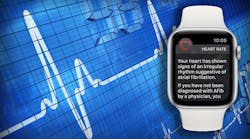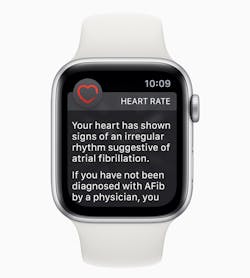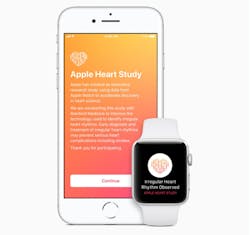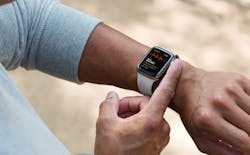The Internet of Things will change how doctors and hospitals monitor a patient’s vitals in and out of the hospital. Wearable devices connected to the internet will provide electronic medical records with data to keep a patient’s medical history up-to-date, monitor ongoing health concerns, and alert medical personnel in times of emergency.
Apple took a huge step toward this potential future when it announced its joint Heart Study research with Stanford University’s School of Medicine. The virtual study enrolled more than 400,000 participants to collect data from their Apple Watch’s heart rate monitoring feature. The study was launched in November 2017 and has been monitoring the participant's heart rate, alerting medical professionals of any irregular heart rhythms.
The heart-rate pulse sensor found in the Apple Watch (in model versions 1 through 4) can identify atrial fibrillation, a condition that often remains hidden because people tend to not experience daily symptoms. Atrial fibrillation results in 130,000 deaths and 750,000 hospitalizations each year according to the CDC. They estimate that the condition affects between 2.7 to 6.1 million people, plus 700,000 more people most likely have undiagnosed atrial fibrillation.
The Apple Watch can notify wearers of possible atrial fibrillation, which results in 130,000 deaths and 750,000 hospitalizations each year, according to the CDC.
The heart rate app would intermittently check the participant’s pulse and, when an irregular beat was detected, the participant would receive a notification to schedule a telemedicine consultation with one of the doctors from the study. Participants were then sent ambulatory electrocardiography (ECG) patches through BioTelemetry, which recorded the electrical rhythm of their hearts up to a week.
The preliminary results from the study have proven the accuracy of these types of wearables. Comparing the irregular pulse detection on the Apple Watch to ECG patch recordings showed the pulse detection algorithm had a 71% positive predictive value. 84% of the time, the participants who received notifications were found to be in atrial fibrillation at the time. 57% of those who received irregular pulse notifications sought medical attention.
The Heart Study is a joint Apple and Stanford University medical research study to observe how wearable medical devices can operate outside of a hospital for patient monitoring.
One of the most important key findings was that out of 419,093 participants, only 0.5% of participants (2,116) received irregular pulse notifications. One of the many concerns among health professionals with wearable health devices is potential over-notification. Patients receiving several notifications can create a burden on the medical industry, having doctors chase down health concerns which are non-life threatening or erroneous.
“The results of the Apple Heart Study highlight the potential role that innovative digital technology can play in creating more predictive and preventive health care,” said Lloyd Minor, M.D., dean of the Stanford School of Medicine. “Atrial fibrillation is just the beginning, as this study opens the door to further research into wearable technologies and how they might be used to prevent disease before it strikes—a key goal of Precision Health.”
The latest Apple Watch can measure a wearer’s electrocardiogram. These types of features can become lifesaving tools as they increase in accuracy.
The new Apple Watch Series 4 is a great example of what a future medical device wearable can offer. It already can detect when someone falls hard enough to cause injury and can notify emergency services to help. Another new feature of note is the ECG tool. By touching the crown on the watch, the wearer completes the necessary conductivity circuit to measure one’s ECG. Apple, for now, has been clear in claiming that the ECG is not a medical diagnostic tool, and merely an indicator for the wearer. However, as the watch increases its accuracy, we can potentially see the watch being used to monitor ECG readings outside of a hospital setting.
“The performance and accuracy we observed in this study provide important information as we seek to understand the potential impact of wearable technology on the health system,” says Marco Perez, M.D., associate professor of cardiovascular medicine at Stanford. “Further research will help people make more informed health decisions.”




